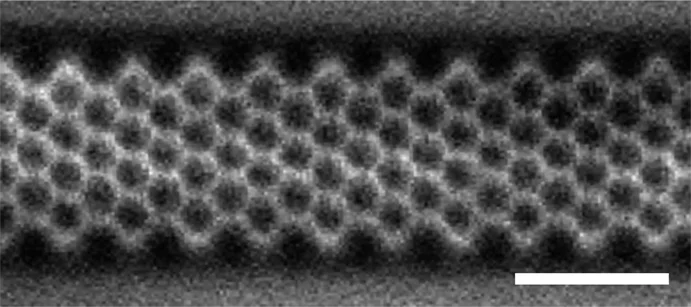One way of introducing a band gap into the electronic structure of graphene is to cut graphene into nanometre-wide ribbons. At this scale, however, even atomic-level roughness at the ribbon edges can seriously degrade the mobility of charge carriers. The basic idea behind the bottom-up approach to graphene nanoribbons (GNRs) is to design precursor molecules that can be used to selectively synthesize GNRs of the desired width and edge structure.
In such an approach, the design of the molecular building block defines the width of the GNRs down to the single atom, providing ultimate control over its electronic band gap. And by using highly purified batches of precursor molecules, GNRs with correspondingly low numbers of defects can be obtained. Yet, for the bottom-up approach to succeed, the precursor molecules need not only to be synthesized as designed but must also satisfy a set of partially competing requirements with respect to size, coupling motifs, polymerization and cyclodehydrogenation conditions. This makes the search for a viable synthetic route towards a given GNR target a challenging task.
In this collaborative work involving scientists from Switzerland, Germany and the U.S., we report the synthesis of armchair graphene nanoribbons with a width of nine carbon atoms on Au(111) through surface-assisted aryl−aryl coupling and subsequent cyclodehydrogenation. The width of nine carbon atoms is obtained with a small molecular precursor that enters the GNR in two different orientations. By combining high-resolution atomic force microscopy, scanning tunneling microscopy, and Raman spectroscopy, we demonstrate that the atomic structure of the fabricated ribbons is exactly as designed. Angle-resolved photoemission spectroscopy and Fourier-transformed scanning tunneling spectroscopy reveal an electronic band gap of 1.4 eV and effective masses of ≈0.1 me for both electrons and holes, constituting a substantial improvement over previous efforts toward the development of transistor applications (for devices based on these GNRs, see https://arxiv.org/abs/1605.06730). Finally, we use ab initio calculations to gain insight into the dependence of the Raman spectra on excitation wavelength as well as to rationalize the symmetry-dependent contribution of the ribbons’ electronic states to the tunneling current.
Contact
Dr. Pascal Ruffieuxnanotech@surfaces Laboratory and NCCR MARVEL Swiss Federal Laboratories for Materials Science and Technology (Empa)
8600 Dübendorf, Switzerland
Telephone: +41 58 765 46 93
E-mail: pascal.ruffieux@empa.ch
Original Publication
On-Surface Synthesis and Characterization of 9-Atom Wide Armchair Graphene NanoribbonsLeopold Talirz, Hajo Söde, Tim Dumslaff, Shiyong Wang, Juan Ramon Sanchez-Valencia, Jia Liu, Prashant Shinde, Carlo A. Pignedoli, Liangbo Liang, Vincent Meunier, Nicholas C. Plumb, Ming Shi, Xinliang Feng, Akimitsu Narita, Klaus Müllen, Roman Fasel, and Pascal Ruffieux
ACS Nano, 11, 1380 (2017).
DOI: 10.1021/acsnano.6b06405
